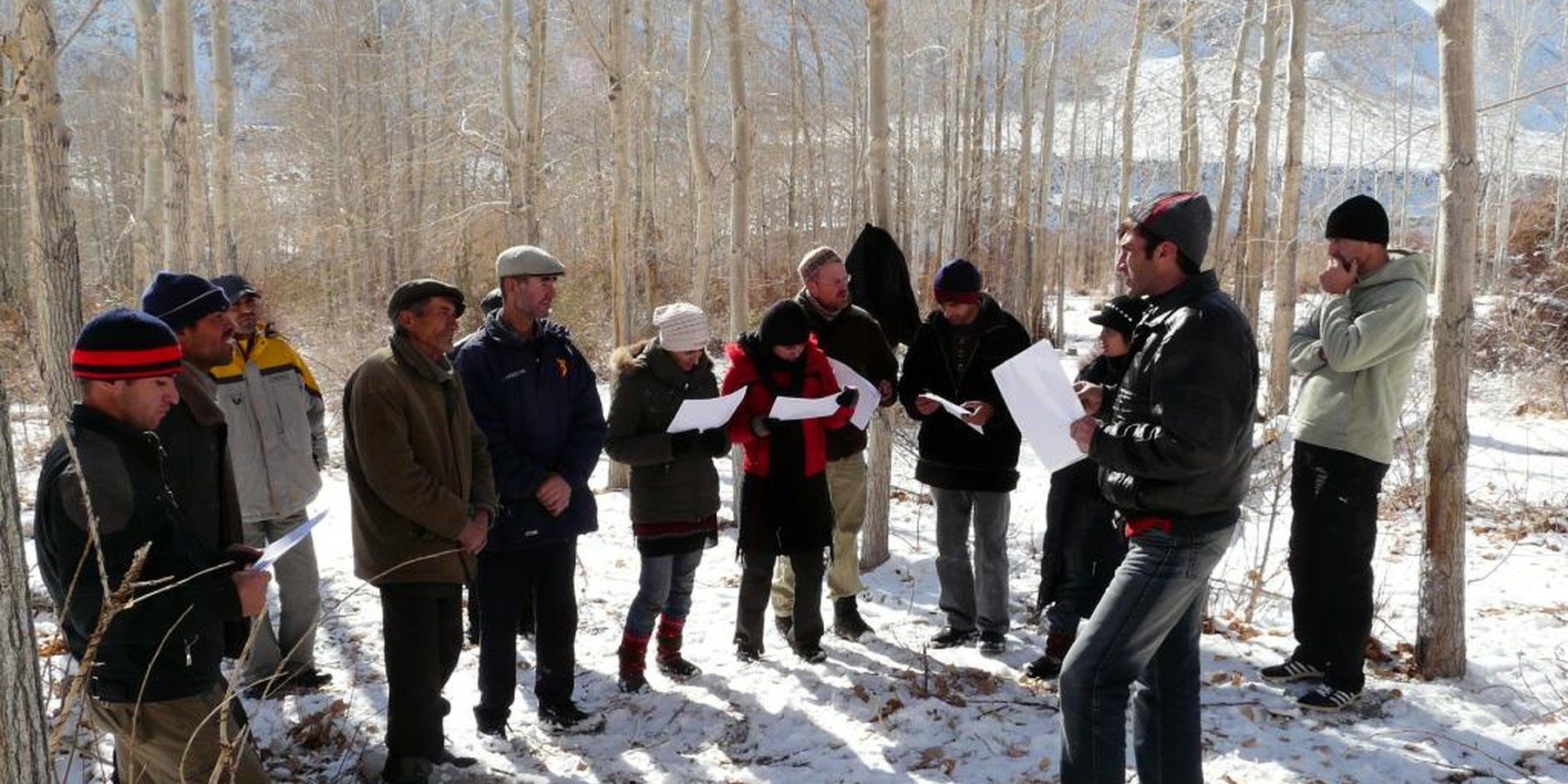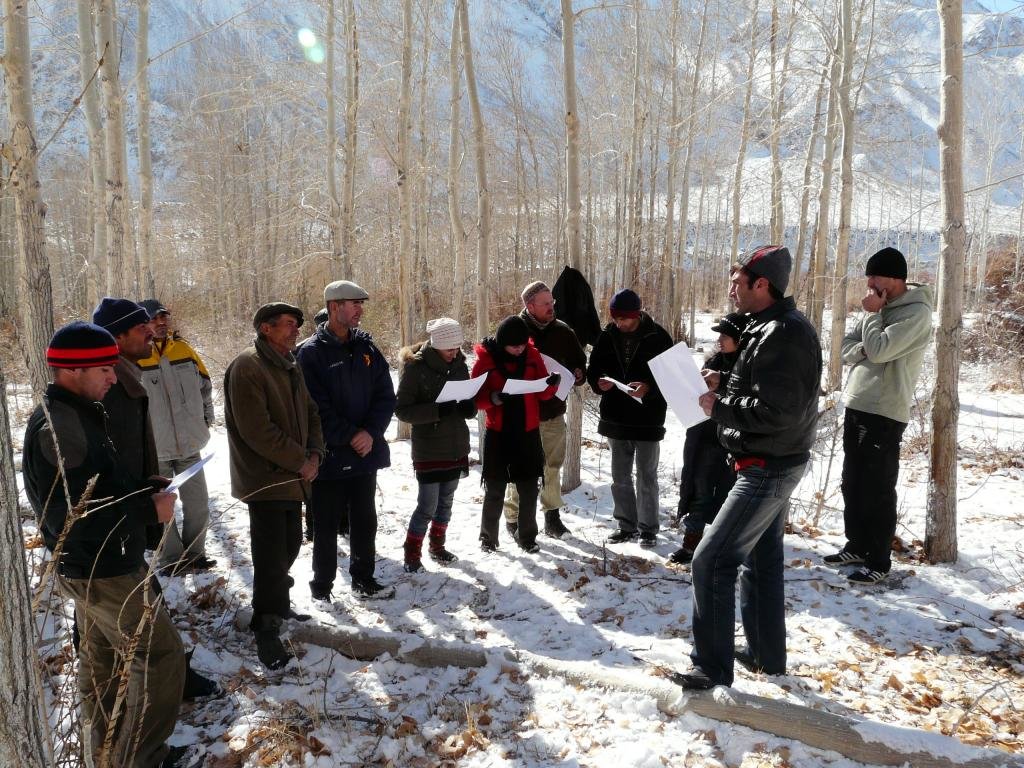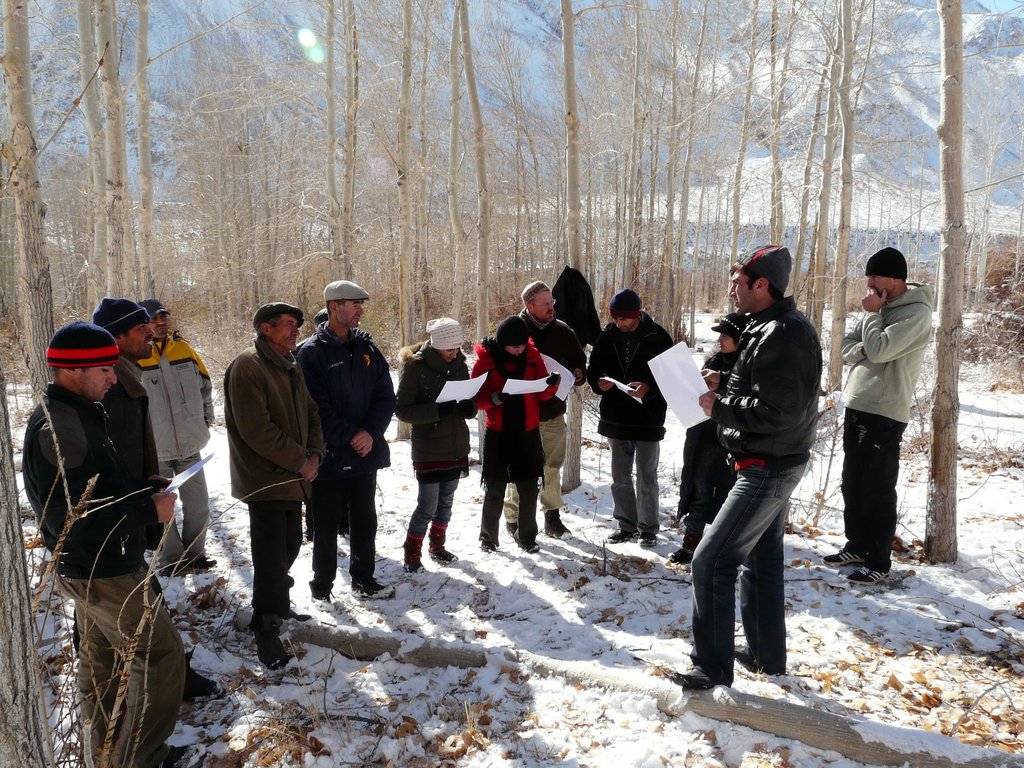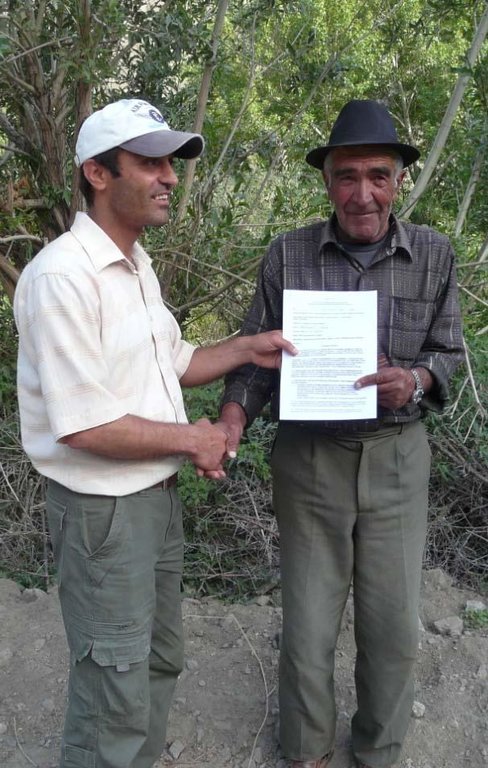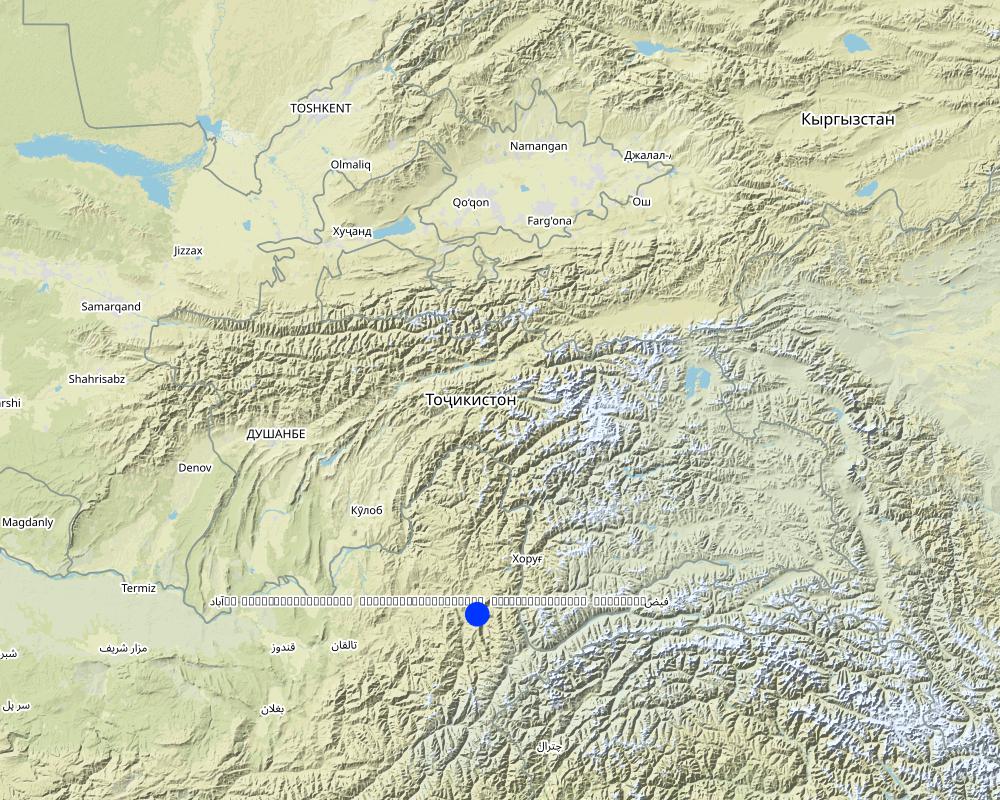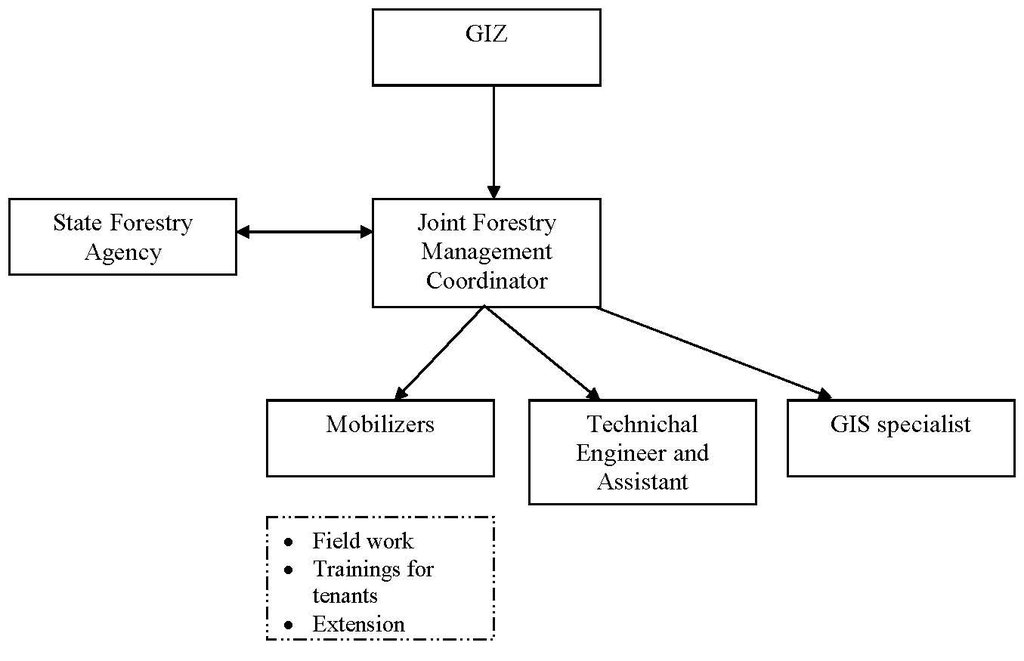Joint Forest Management (JFM) [Tajiquistão]
- Criação:
- Atualização:
- Compilador/a: Roziya Kirgizbekova
- Editor: –
- Revisores: David Streiff, Alexandra Gavilano, Joana Eichenberger
Совместное управление лесами (СУЛ) (Russian)
approaches_2431 - Tajiquistão
Veja as seções
Expandir tudo Recolher tudo1. Informação geral
1.2 Detalhes do contato das pessoas capacitadas e instituições envolvidas na avaliação e documentação da abordagem
Especialista em GST:
Especialista em GST:
Angermann Michael
+992 935 747318
michael.angermann@giz.de
GIZ, Sustainable Management of Natural Resources in Gorno-Badakhshan
Okhonjon Str. 58-1, 736000 Khorog, Tajikistan
Alemanha
Especialista em GST:
Neusel Benjamin
+992 935 747312
benjamin.neusel@cimonline.de
GIZ, Sustainable Management of Natural Resources in Gorno-Badakhshan
Okhonjon Str. 58-1, 736000 Khorog, Tajikistan
Alemanha
Especialista em GST:
Kirchhoff Joachim F.
+992 44 6006702
joachim.kirchhoff@giz.de
GIZ, Regional Program on Sustainable Use of Natural Resources in Central Asia
Ayni Str./Nazarshoev Str., 734026 Dushanbe
Alemanha
Nome do projeto que facilitou a documentação/avaliação da Abordagem (se relevante)
Central Asian Countries Initiative for Land Management (CACILM I)Nome do projeto que facilitou a documentação/avaliação da Abordagem (se relevante)
Pilot Program for Climate Resilience, Tajikistan (WB / PPCR)Nome da(s) instituição(ões) que facilitou(ram) a documentação/avaliação da Abordagem (se relevante)
Deutsche Gesellschaft für Internationale Zusammenarbeit (GIZ) GmbH (GIZ) - Alemanha1.3 Condições em relação ao uso da informação documentada através de WOCAT
Quando os dados foram compilados (no campo)?
23/08/2009
O/a compilador/a e a(s) pessoa(s) capacitada(s) aceitam as condições relativas ao uso de dados documentados através da WOCAT:
Sim
1.4 Referência ao(s) questionário(s) sobre tecnologias da GST
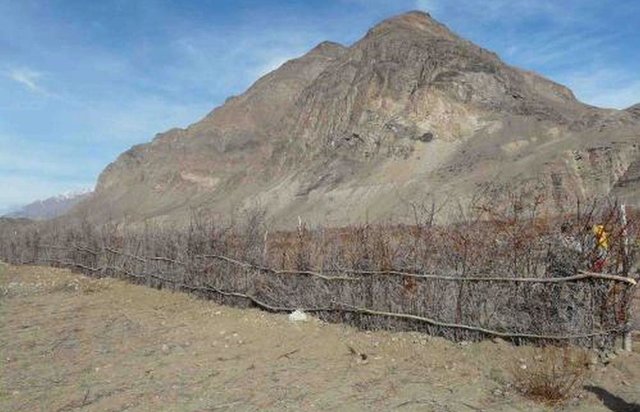
Establishment of living seabuckthorn fences for the protection … [Tajiquistão]
Protection of reforestation sites (willow, poplar and fruit trees) through living seabuckthorn perimeter fencing on Joint Forestry Management plots.
- Compilador/a: Roziya Kirgizbekova
2. Descrição da abordagem de GST
2.1 Descrição curta da abordagem
Protection and rehabilitation of state forests based on joint long term agreements set up between the State Forestry Agency, and local forest users (in the frame of CACILM).
2.2 Descrição detalhada da abordagem
Descrição detalhada da abordagem:
Aims / objectives: In Soviet times, the Gorno Badakhshan Autonomous Region (GBAO) had been highly dependent on subsidised fuel for heating and cooking. After independence, as fuel could no longer be imported from the former Soviet Union, more pressure was exerted on the flood plain forests, leading to severe degradation of the resources through illegal felling and livestock grazing. The State Forestry Agency does not have the financial means nor adequate capacity to implement a sustainable forestry management system adapted to the changed political, socio-economic and ecological conditions. The main aim of this approach is the rehabilitation of degraded floodplain forests in collaboration with the local users. This can only be achieved, if local users can see that they will benefit from conserving and developing the forest. Also, the State Forestry Agency is supported in its restructuring and gets an opportunity to achieve the protection of the forest, and economic goals through forest products and income from the rented forest plots.
Methods: \'Joint Forest Management\' (JFM) means that governmental organisations and local users are involved in forest management on the basis of a contract with a duration of 20 years, valid under Tajik law, which defines the rights and obligations of all the parties. As a first step, and in order to ensure the protection of the plot, a fence has to be built to protect reforestation activities from livestock (see Technology TAJ366). Adequate irrigation of the forest areas is also supported. Forest tenants as well as Forestry Agency staff are also trained in sustainable forest management techniques. Progresses and challenges are regularly being monitored and technical advice is being given to forest tenants.
Stages of implementation: The implementation includes eight steps: (1) field check and meeting with village representatives, (2) information workshop, (3) general agreement with the whole community, (4) selection of tenants, (5) division of the plots, (6) signing of contracts with the individual tenants, (7) elaboration of management plans and annual plans for each tenant, and (8) monitoring of annual plans.
Role of stakeholders: The annual plan is based on a 5-year management plan for the respective plot. It determines the amount of work undertaken by the forest tenant as well as harvests and their shares to be obtained from the rented area in one year. The rental contract, the management plan, and the annual plan are mutually agreed on by the forest tenants and the Forestry Agency. Forest tenants develop a sense of ownership and responsibility for the sustainable use of forests and forest resources on their plot. The State Forestry Agency is responsible for control and technical advice.
2.3 Fotos da abordagem
2.5 País/região/locais onde a abordagem foi aplicada
País:
Tajiquistão
Região/Estado/Província:
Tajikistan Gorno Badakhshan Autonomous Region (GBAO)
Especificação adicional de localização:
Ishkashim, Roshtkala, Shugnan
Comentários:
This approach is currently implemented in the districts of Shugnan, Roshtkala and Ishkashim in GBAO, and each year, the area covered is gradually increasing.
Map
×2.6 Datas de início e término da abordagem
Indique o ano de início:
2009
2.7 Tipo de abordagem
- Baseado em projeto/programa
2.8 Principais metas/objetivos da abordagem
The Approach focused mainly on SLM with other activities (Income generation, income diversification, forest rehabilitation, improved access to forest resources)
Protection and rehabilitation of state forests based on joint long term agreements set up between the State Forestry Agency, and local forest users.
The SLM Approach addressed the following problems: Limited management and control capacities of the State Forestry Agency, combined with a sudden increasing need for firewood resulted in an uncontrolled 'open access' situation in the floodplain forests of GBAO. People were using forest resources in an unsustainable manner, including uncontrolled felling and livestock pasture. This resulted in a large scale degradation of the floodplain forest resources.
2.9 Condição que propiciam ou inibem a implementação de tecnologia/tecnologias aplicada(s) segundo a abordagem
Disponibilidade/acesso a recursos e serviços financeiros
- Inibitivo
No funds available for the rehabilitation of irrigation infrastructure.
Treatment through the SLM Approach: Initial set up investments co-financed by international NGOs (GIZ).
Quadro institucional
- Inibitivo
No organisational structures for overall local management of rented state forests in place, including conflict solving mechanisms between stakeholders from different administrative levels.
Treatment through the SLM Approach: Establishment of Joint Forest Management council at local level.
Quadro jurídico (posse de terra, direitos de uso da terra e da água)
- Inibitivo
User rights for state forest were exclusively with the State Forestry Agency. Locals used the forests illegally.
Treatment through the SLM Approach: Contracts with individual tenants providing them with long-term user rights and responsibilities.
The existing land ownership, land use rights / water rights greatly hindered the approach implementation The forest land is in State property, the State Forestry Agency has exclusive user rights, however open access leads to uncontrolled use of forest resources by the local people. Restricting access can help create clear regulations, but these are not always accepted by villagers who prefer illegal open access to natural resources.
Carga de trabalho, disponibilidade de força de trabalho
- Inibitivo
After the collapse of the Soviet Union, the Forestry Agency had insufficient financial and human resources to manage the state forests.
Treatment through the SLM Approach: Responsibilities and workload are shared with the local population.
Outro
- Inibitivo
The State Forestry Agency lacks finances and capabilities to manage forest resources.
Treatment through the SLM Approach: Support of the Agency for internal reforms and the introduction of a sustainable forest management scheme (JFM).
3. Participação e papel das partes interessadas envolvidas
3.1 Partes interessadas envolvidas na abordagem e seus papéis
- Usuários de terra/comunidades locais
Women and men, rich and poor are involved equally
Actual implementation in close cooperation with the other bodies
- Especialistas em GST/ consultor agrícola
GIZ project staff and forest specialists
Supporting local users in implementing the Technology with some modifications.
The Approach has been designed by an international specialist, and some components by a local specialist
Conducting workshops, providing technical advice
- Organização não governamental
International non-government
Coordination and financing of the project, design of the approach
- Governo local
Support during implementation
Cooperation, approval of the legal framework
- Governo nacional (planejadores, responsáveis pelas decisões)
Support during implementation
Cooperation, approval of the legal framework
Caso várias partes interessadas foram envolvidas, indique a agência líder:
GIZ
3.2 Envolvimento do usuários de terra/comunidades locais nas diferentes fases da abordagem
| Envolvimento do usuários de terra/comunidades locais | Especifique quem estava envolvido e descreva as atividades | |
|---|---|---|
| Iniciação/motivação | Participativo | Field visits, talks with village representatives, information seminar for the whole community. |
| Planejamento | Participativo | 5-year Management Plans and 1-year Annual Plans are developed for each forest plot, jointly by the land users and State Forestry Agency staff. |
| Implementação | Participativo | Live fence construction, irrigation rehabilitation, sharing of harvest. |
| Monitoramento/avaliação | Participativo | Completed via the close cooperation between the State Forestry Agency and GIZ, using interviews completed by project mobilisers, as well as monitoring of annual achievements. |
| Research | Nenhum |
3.3 Fluxograma (se disponível)
Descrição:
Organisational chart shows how the project staff work with the State Forestry Agency.
Autor:
Sady Odinashoev (Tajikistan, Dushanbe)
3.4 Decisão sobre a seleção de tecnologia/tecnologias de GST
Especifique quem decidiu sobre a seleção de tecnologia/tecnologias a serem implementadas:
- Principalmente especialistas em GST, após consulta com usuários da terra
Explique:
The approach was developed and implemented in other geographical settings (South Asia) and adapted to the local conditions in GBAO. It is continuously being adapted, according to the practical experiences of SLM specialists and through consultation with the local forest tenants.
Decisions on the method of implementing the SLM Technology were made by mainly by land users supported by SLM specialists. GIZ project staff and forest specialists supported local users in implementing the Technology with some modifications.
4. Suporte técnico, reforço das capacidades e gestão do conhecimento
4.1 Reforço das capacidades/ formação
Foi oferecida formação aos usuários da terra/outras partes interessadas?
Sim
Especifique quem foi capacitado:
- Usuários de terra
- Equipe de campo/consultores
Caso seja relevante, especifique gênero, idade, status, etnia, etc.
At first, so called 'community mobilisers' were trained, who further provided training for forest users.
Tipo de formação:
- Em exercício
- Áreas de demonstração
- Reuniões públicas
- Cursos
Assuntos abordados:
Sustainable natural resources management, technical forestry knowledge (planting, thinning) and elaboration of management plans.
4.2 Serviço de consultoria
Os usuários de terra têm acesso a um serviço de consultoria?
Sim
Especifique se foi oferecido serviço de consultoria:
- nas áreas dos usuários da terra
Descreva/comentários:
Forestry training for tenants and forestry staff; Key elements: Sustainable natural resource management and use, Technical training in forestry management (planting and harvesting, fencing etc.)
Advisory service is quite adequate to ensure the continuation of land conservation activities; Government saw the good results gained from the Joint Forest Management approach, and is interested in continuing this approach.
4.3 Fortalecimento da instituição (desenvolvimento organizacional)
As instituições foram fortalecidas ou estabelecidas através da abordagem?
- Sim, significativamente
Especifique a que nível (níveis) as instituições foram fortalecidas ou estabelecidas:
- Local
Especifique o tipo de apoio:
- Financeiro
- Reforço das capacidades/ formação
Dê mais detalhes:
The State Forestry Agencie's building was renovated and computers were provided for the Agency. Mobilisers were trained to conduct advisory services. Transport for field works was provided. The State Forestry Agency is being supported in its restructuring towards becoming a sustainable institution
4.4 Monitoramento e avaliação
Monitoramento e avaliação são partes da abordagem?
Sim
Comentários:
Area treated aspects were regular monitored by project staff through observations; indicators: GIS and data base systems were established
No. of land users involved aspects were ad hoc monitored by project staff, government through observations; indicators: based on the number of contracts, registered in data base
area treated aspects were regular monitored by project staff, government, land users through measurements; indicators: GIS and data base systems were established
bio-physical aspects were regular monitored by project staff, government through observations; indicators: annual monitoring (autumn)
no. of land users involved aspects were ad hoc monitored by project staff, government, land users through measurements; indicators: based on the number of contracts
management of Approach aspects were regular monitored by None through observations; indicators: regular planning, reporting and evaluation
There were several changes in the Approach as a result of monitoring and evaluation: Regular adaptation of the approach after evaluation and analysis of field work results and occurring challenges.
There were no changes in the Technology as a result of monitoring and evaluation: None
4.5 Pesquisa
A pesquisa foi parte da abordagem?
Não
5. Financiamento e apoio material externo
5.1 Orçamento anual para o componente de GST da abordagem
Caso o orçamento exato seja desconhecido, indique a faixa:
- 10.000-100.000
Comentários (p. ex. principais fontes de recursos/principais doadores):
Approach costs were met by the following donors: local community / land user(s) (Implementation of measures in the forest are covered by land users): 10.0%; government (Provision of areas for JFM implementation, support of implementation): 10.0%; international (Full project organisation: meetings, workshops, technical advice): 80.0%
5.2 Apoio financeiro/material concedido aos usuários da terra
Os usuários da terra receberam apoio financeiro/material para a implementação de tecnologia/tecnologias?
Não
5.3 Subsídios para entradas específicas (incluindo mão-de-obra)
- Equipamento
| Especifique quais entradas foram subsidiadas | Em que medida | Especifique os subsídios |
|---|---|---|
| Maquinário | Totalmente financiado | Excavator |
- Infraestrutura
| Especifique quais entradas foram subsidiadas | Em que medida | Especifique os subsídios |
|---|---|---|
| Irrigation infrastructure | Totalmente financiado | Rehabilitation of some irrigation infrastructure |
Se a mão-de-obra pelos usuários da terra foi uma entrada substancial, isso foi:
- Recompensado com outras formas de apoio material
Comentários:
Also voluntary labour was an important input
5.5 Outros incentivos ou instrumentos
Foram utilizados outros incentivos ou instrumentos para promover a implementação das tecnologias de GST?
Sim
Caso afirmativo, especifique:
The State Forestry Agencie's building was renovated and computers were provided for the Agency. Mobilisers were trained to conduct advisory services. Transport for field works was provided. The State Forestry Agency is being supported in its restructuring towards becoming a sustainable institution
6. Análise de impactos e declarações finais
6.1 Impactos da abordagem
A abordagem auxiliou os usuários da terra a implementar e manter as tecnologias de GST?
- Não
- Sim, pouco
- Sim, moderadamente
- Sim, significativamente
The vegetation cover of the forest plots under JFM was improved through better protection and planting. No open access to forests was allowed, which prevents illegal and uncontrolled use of forest resources.
A abordagem melhorou as questões de posse de terra/diretos do usuário que inibiam a implementação das tecnologias de GST?
- Não
- Sim, pouco
- Sim, moderadamente
- Sim, significativamente
User rights are clearly assigned according to the law of the Republic of Tajikistan. Tenants and local people developed a sense of ownership and responsibility for the sustainable use of forests and forest resources.
Did other land users / projects adopt the Approach?
- Não
- Sim, pouco
- Sim, moderadamente
- Sim, significativamente
Did the Approach lead to improved livelihoods / human well-being?
- Não
- Sim, pouco
- Sim, moderadamente
- Sim, significativamente
As a result of better protection and rehabilitation, people can legally sell the surplus of harvested firewood, non-timber forest products etc., which adds to their family's income.
Did the Approach help to alleviate poverty?
- Não
- Sim, pouco
- Sim, moderadamente
- Sim, significativamente
Good sites allow for immediate sale and own consumption of fire wood and non-timber forest products. Heavily degraded sites will produce income in about 5 years after rehabilitation and maintenance.
6.2 Principal motivação dos usuários da terra para implementar a GST
- Produção aumentada
Firewood
- normas e regulamentos (multas)/aplicação
Contract based legal access to forest
- well-being and livelihoods improvement
Possibility to have revenues from selling forest products (and products for own consumption)
6.3 Atividades de sustentabilidade de abordagem
Os usuários da terra podem manter o que foi implementado através da abordagem (sem apoio externo)?
- Sim
Caso afirmativo, descreva como:
Much interest among the land users as they have now legal access to the forest.
6.4 Pontos fortes/vantagens da abordagem
| Pontos fortes/vantagens/oportunidades na visão do usuário da terra |
|---|
| Trusting Forestry Agency (How to sustain/ enhance this strength: Follow the rules established in the contracts and management plans.) |
| Benefit through legal access to forest products (firewood, construction, wood, fruits, etc) |
| Pontos fortes/vantagens/oportunidades na visão do/a compilador/a ou de outra pessoa capacitada |
|---|
| Improved forest protection and management (How to sustain/ enhance this strength: Forest users have a sense of ownership and responsibility for the sustainable use of forests and forest resources. Close collaboration of the Forestry Agency with the forest tenants will be crucial.) |
| Benefit through legal access to forest products (firewood, construction, wood, fruits. etc) (How to sustain/ enhance this strength: Contract guarantees user rights for 20 years. Good management assured through regular advice and monitoring by the Forestry Agency (twice a year in spring and autumn).) |
6.5 Pontos fracos, desvantagens da tecnologia e formas de superá-los
| Pontos fracos/desvantagens/riscos na visão do usuário da terra | Como eles podem ser superados? |
|---|---|
| At the beginning of the project, benefits seen to be gained from the forest are not high (especially wood) | Planting of fast growing bushes and trees, perennial, fodder crops. |
| Pontos fracos/vantagens/riscos na visão do/a compilador/a ou de outra pessoa capacitada | Como eles podem ser superados? |
|---|---|
| At the initial stage, financing of the approach without project (INGO) support is difficult | In the future, by increasing the productivity of the forest areas, more finances can possibly be made available to forest users and the forestry department. |
7. Referências e links
7.1 Métodos/fontes de informação
- visitas de campo, pesquisas de campo
- entrevistas com usuários de terras
7.2 Referências às publicações disponíveis
Título, autor, ano, ISBN:
Forestry Sector Analysis of the Republic of Tajikistan, Joachim F. Kirchhoff and André Fabian, 2010
Disponível de onde? Custos?
Contact: jochim.kirchhoff@giz.de or michael.angermann@giz.de
Links e módulos
Expandir tudo Recolher tudoLinks

Establishment of living seabuckthorn fences for the protection … [Tajiquistão]
Protection of reforestation sites (willow, poplar and fruit trees) through living seabuckthorn perimeter fencing on Joint Forestry Management plots.
- Compilador/a: Roziya Kirgizbekova
Módulos
Não há módulos


